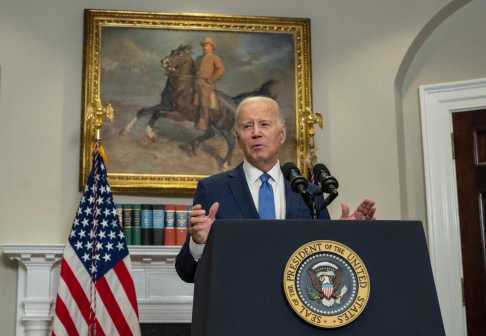The White House wants to make civic leave for technologists normal and accessible. Will it take off?

Civic service leave got the official White House summit treatment this week.
On Monday, the executive branch convened around 150 tech leaders, including representatives of Amazon, Apple, Adobe and more, in order to “explore ways for more people to take a civic tour of duty,” as Chris Liddell, White House deputy chief of staff for policy coordination, put it in a statement.
The summit is the biggest push to date for this relatively nascent concept, a process by which private sector tech employees may take a leave of absence from the hallowed halls of places like Google or Microsoft for a short-term appointment in government. But the interest doesn’t come out of nowhere — behind the scenes, an informal group that includes a White House office, a range of tech companies and even some industry associations has been working hard to make civic leave accessible.
Here’s what that looks like, and some of the challenges both companies and the government are facing along the way.
Like pro bono, but for technologists
The blueprint for civic leave for technologists, proponents say, is simple. Many professions, like law and medicine, have an inbuilt culture of civic work — think working pro bono hours or joining Doctors Without Borders. If you work in law or medicine, you probably have a colleague or mentor who has participated in a program like this, and the familiarity breeds comfort.
Tech, a comparatively young industry, doesn’t have that well-laid path. But with the rise in digital-native groups in government like the U.S. Digital Service and the General Services Administration’s 18F, short-term appointments have become possible. Now, proponents want to push pro bono for tech into the mainstream.
“The country benefits when patriotic citizens with technical expertise choose to serve at the federal, state or local level,” Liddell explained.
Industry group BSA | The Software Alliance, which boasts members like Adobe, IBM, Slack and others, has been working closely with the White House Office of American Innovation to align government needs and company expectations when it comes to making civic leave a reality.
Fundamentally, BSA Vice President of Legislative Strategy Craig Albright told FedScoop, the exchange of talent can be a win-win-win — for employees, their companies and the government.
For the employee, a turn in government can be a career accelerant. Even as a junior employee, he said, “the government is a place where you can be handed responsibility.”
For the companies? “If the government were able to make use of technology more effectively, then that certainly creates opportunities for [software vendors],” he said. But there’s a deeper interest, too, he argued. “The technology industry does have a deep sense of wanting to do good, wanting to make things better, wanting to solve problems. It’s just part of the culture.”
And the government, finally, gets talent — talent that, conventionally, might prove to be otherwise inaccessible.
The U.S. Digital Service’s Eddie Hartwig, recently named the office’s deputy administrator, told FedScoop that the value of civic service is that it extends the possible field of prospects. Recruiting to USDS is hard, he said, because it must “catch people right at that moment,” when they want a new opportunity but are OK with the time limits that come with the organization’s short-term employment strategy. The promise of a private sector job that one can return to after a few months in government may encourage a greater diversity of people to take the leap into public service, Hartwig said.
‘The things that our engineers can do, no one else in the world can do’
There are a number of major American tech companies that already have established civic leave policies, including Google, Adobe and Microsoft. For Adobe, it all began three or four years ago.
“We were looking at groups like the U.S. Digital Service and 18F that were really getting some momentum in the government and wondering if there’s a way to get employees involved,” Jace Johnson, Adobe’s head of government relations, told FedScoop.
The company realizes that it has a resource — talent — that the government often finds it hard to come by. “The things that our engineers can do, no one else in the world can do,” Johnson said. And these engineers, he added, get really excited about the types of problems the government must solve.
By poking around internally, Johnson discovered that Adobe’s standard leave policy is actually pretty flexible. Employees could theoretically utilize an Adobe leave of absence for any number of reasons, from working for an NGO to taking a turn of civic service and more.
Despite this, many employees don’t know that civic leave is an option. So Johnson began a sort of internal marketing campaign. Exposing tech talent to the opportunities available, he said, “seems to be the best role that we can play.”
A model policy
Microsoft, according to multiple interviewees, is thought to have the most advanced civic leave policy.
A look at the company’s policy document and attendant “civic leave application,” a copy of which was obtained by FedScoop, provides insight into how it’s handled there. The document precisely lays out who is eligible for civic leave, how to request it, what happens to benefits and bonuses while they’re away, and the conditions of return.
“Microsoft allows leaves for significant work that is an opportunity for employees to apply the skills normally used in the course of their work for Microsoft to advance civic goals, and to gain skills that can provide development opportunities and increase market knowledge,” the policy reads.
Employees with two years of work under their belts at the company and a good performance history are eligible for the leave; the application for interested employees requires basic information about the position and why it’s a good fit or opportunity. Microsoft offers to keep positions open for employees to return to “to the extent feasible” for up to 12 weeks. Civic leave for more than 18 months is not typically granted, the policy states.
Microsoft declined to comment for this article.
‘There’s definitely interest,’ but will it take off?
So who participates in civic leave? Finding numbers and specific stories can be challenging. Most tech companies that allow civic leave don’t have readily available data on their use of it. Johnson said there have “undoubtedly” been Adobe employees who have used their leave to do civic work, but that the company doesn’t track specifics.
USDS also does not have a sense for how many people join while on civic leave; USDSers are treated the same whether they plan to return to a previous employer after serving or not, Hartwig said.
A White House official, meanwhile, estimated “a couple thousand” tech employees total, from various companies, have joined government for term appointments — a number the White House wants to scale up. “The more people do it the easier it becomes,” the official added.
But those thousands might not be “doing it” in a strict sense. One anecdotal issue that Johnson and others mentioned is that some employees who take civic leave don’t ever return to the original company — instead staying in government longer than expected or using the experience as a “springboard” for their next role.
“We [at Adobe] don’t view that as a bad thing,” Johnson said. But it’s easy to see why some companies might have a different opinion, and discourage civic leave out of the fear that it’ll cost them their workforce.
Another challenge inherent in talking about civic leave may be its resemblance to a kind of revolving door for the metaphorical “swamp” of Washington. But government officials are quick to assuage concerns that civic leave could create too cozy a relationship between government and industry.
According to Office of Management and Budget rules, Hartwig said, USDSers who plan to go back to a private sector company are barred from working on projects relating to that company while in service at USDS.
The White House official said maintaining neutral distance needs to be “a huge priority of any kind of public service,” and cited “existing mechanisms” that can help. “This is one of the areas where federal policy is helpful,” the official said. “The regulations around procurement, etcetera are pretty clear-cut.”
At this point, it remains to be seen if civic leave will become as de rigueur in tech as similar acts of service are in other career areas. However, significant stakeholders seem aligned on trying to promote it moving forward, whether through further White House summits or something else.
“It’s a priority for us,” the White House official said.






